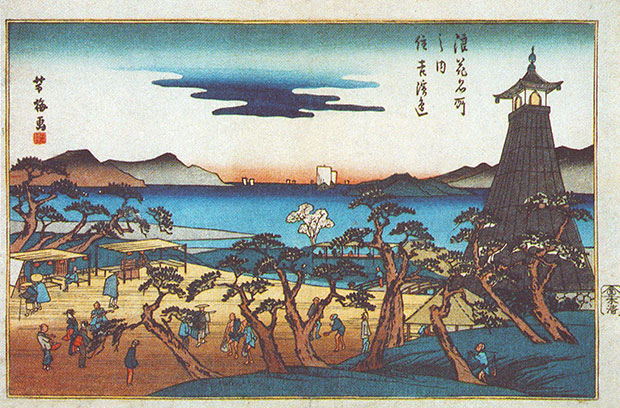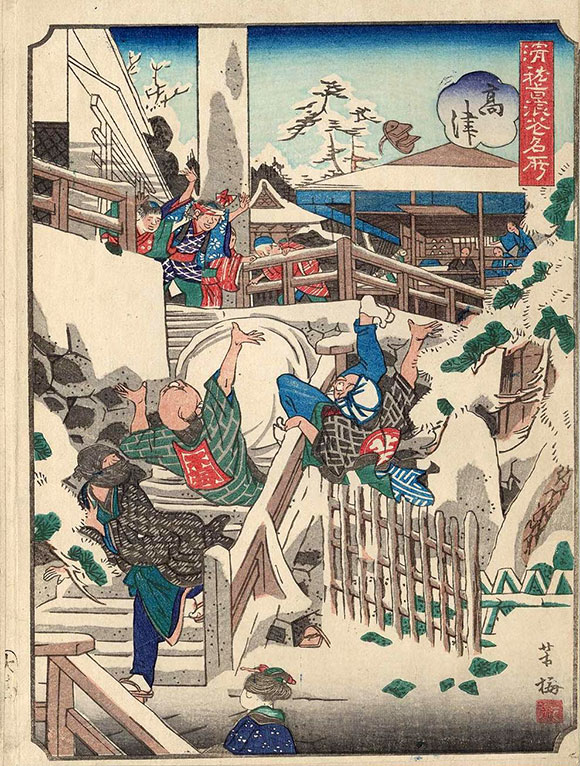

Ichiôsai YOSHIUME (一鶯齋芳梅)
|
Ichiôsai Yoshiume (一鶯齋芳梅 1819–79, act. c. 1841–1850s) was one of the leading Osaka ukiyo-e artists of his day, and a mentor of many pupils. He studied with the Edo artist Utagawa Kuniyoshi (歌川國芳 1898-1861) around 1847. Yoshiume's Osaka address is known to have been in Horie district bordered by the Nagahori Canal (north), Nishiyokobori Canal (east), the Dôtonbori Canal (theater area to the south), and Kizu River (west). He worked as an illustrator for woodblock-printed books, but he also designed many nishiki-e (color woodblock prints: 錦絵), including chûban- and ôban-format actor prints as well as ôban-format landscapes (fûkeiga: 風景画), pictures of manners and customs (fûzokuga: 風俗画), and giga (comical or playful pictures: 戯画 or 戯畫). Moreover, he also produced a few warrior prints (musha-e: 武者絵), including single-sheet designs and triptychs, very much in the manner of his teacher Kuniyoshi.
 |
Ichiôsai Yoshiume |
Yoshiume's earliest datable work is an ôban-format actor print for a New Year performance. Shown above, it portrays Arashi Tokusaburô III (嵐徳三郎) as Ohatsu (おはつ) in Kagamiyama sato no kikgaki (Picture of the Pleasure Quarter at Mirror Mountain: 加賀見山廓写本), Ônishi Theater (大西の芝居), 1/1841. This play appears to be a variant of Kagamiyama kokyô no nishiki-e (A brocade picture of the birthplace at Mirror Mountain: 鏡山舊錦絵), one of several Kagamiyama mono (Kaga Mountain plays: 鏡山物) dramatizing eighteenth-century rivalries within the Maeda clan in Kaga. The main plot line was based on a real-life incident from 1724 when the maidservant Osatsu avenged the death of her mistress, Omichi, who had been driven to suicide after being struck by a sandal — considered a terrible insult — by a lady-in-waiting named Sawano. Other historical events said to have influenced theatrical retellings were the troubles in the Maeda family, rulers of the Kaga Province, in the 1740s and 1750s. In typical fashion, theatrical adaptations changed the names of the protagonists. After the lady-in-waiting Onoe uncovers a plot to seize power from the shogun by an court woman named Iwafuji, the latter insults Onoe by striking her with a sandal. Onoe commits suicide, but only after revealing the conspiracy to her maid, Ohatsu. The dutiful maid foils the intrigue and kills Iwafuji with a sword, then symbolically beats the corpse with Onoe’s blood-stained sandal.
One of Yoshiume's fûkeiga series was titled Naniwa meisho no uchi (From Famous Places in Osaka: 浪花名所の内) in horizontal ôban format, published by Honsei (Honya Seishichi: 本や清七), in which he followed the style recently established by Utagawa Hiroshige I in his various Tôkaidô series, as well as in his Naniwa meisho of 1834-35. Thus, Yoshiume's set of prints has been dated to a few years after Hiroshige's fûkeiga, possibly as early as 1838, although no definitive year has been confirmed. For a design from this series, see the image below for the view of Sumiyoshi Takadôrô (Lighthouse ["Lantern-tower"] at Sumiyoshi: 住吉高灯篭), Osaka. Sadly, the tower was destroyed by typhoon June 1950; it was rebuilt in stone. The original lighthouse, which burnt rapeseed oil to fuel the lantern, was first constructed and used as an offering to the guardian deity of Sumiyoshi Shrine at the end of the Kamakura period (1185–1333), making it Japan’s oldest lighthouse.
 |
Ichiôsai Yoshiume |
Around the Kaei era (1848–54), Yoshiume produced a large series of giga titled Kokkei Naniwa meisho (Comical Views of Famous Places in Osaka: 滑稽浪花名所) in vertical chûban format. The set was issued by Daijin (大甚), who was active from the late 1840s to the late 1850s as a small publisher or book/print seller at Kyômachi Kinokuniya-bashi Kitazume Kitairu, Kyoto. In the example shown below, a giant snowball has been pushed down some stairs, knocking over two fellows and chasing away a third who runs for his life. A solitary sandal has been flipped into the air. This sort of pratfall humor was exceedingly popular among the average folk of Japan and so scenes such as this one often appear in ukiyo-e. Note, however, the very competent rendering of a snow scene à la Hiroshige, clearly demonstrating Yoshiume's mastery of that particular fûkeiga style.
 |
Ichiôsai Yoshiume |
An example of Yoshiume's warrior prints is shown below, a portrayal of Takeuchi Daijin Sukune (武内大臣宿称) from Honchô Suikoden no uchi ("From the Suikoden in our Realm": 本朝水滸伝之内), circa 1840. The portrayal was inspired by a fourteenth-century Chinese novel, Shuihu zhuan ("Tales of the water margin"), but adapted from Japanese mythology. The Chinese chronicle was a rousing epic glorifying the exploits of a band of righteous outlaws sworn to fight injustice and corruption of government officials while remaining loyal to the emperor, hoping that he would exterminate those who had compromised his reign. In Japan, curiosity about the exploits of heroic historical figures increased dramatically with the publication of serialized illustrated novels called yomihon ("books for reading": 讀本 or 読本). Okajima Kanzan (岡島冠山 1674–1728) translated the first ten parts of the Suikoden into vernacular Chinese (published in Kyoto in 1728). The remaining chapters appeared between 1757 and 1790. The saga truly became a hit when the first ten parts were adapted for the Japanese reading public by a dream duo — the writer Kyokutei Bakin (曲亭馬琴 1767–1848) and the Edo print and painting master Katsushika Hokusai (葛飾北齋 1760-1849) — for the yomihon "New illustrated edition of the Suikoden" (Shinpen suikogaden) during 1805–07. Then, the project lay dormant until it was resumed in 1828 with the less-gifted writer Takai Ranzan (高井蘭山 1762–1838) composing the last 80 parts. Takai first collaborated with Hokusai and then with Hokusai's pupil Katsushika Taitô II (葛飾戴斗 active c. 1810s–50s) until the yomihon was completion in 1838.
 Yoshiume's design is an ireki ("inserted wood": 入木) adaptation of a design by Ryûsai Shigeharu featuring the actor Arashi Rikan II (嵐璃寛) in a scene that is stylistically related to portrayals of Suikoden heroes (see image at right). The owner of the rights to the original carved block, the publisher Wataki (Wataya Kihei: 綿屋喜兵衞), had Shigeharu's design modified with a new head (drawn by Yoshiume) and artist's signature ("Utagawa Yoshiume"), as well as new color blocks for the hakama (袴) or wide pants. The laudatory inscription about Rikan was replaced by an informative text regarding Takenouchi Daijiu Sukune. Presumably, in 1829 or 1830, Shigeharu and Wataki had been inspired or prompted by a renewed craze for the Suikoden saga following a ground-breaking and popular series of prints begun in 1827 by the Edo artist Utagawa Kuniyoshi (1797–1861), titled Tsûzoku Suikoden gôketsu hyakuhachinin no hitori ("The 108 heroes of the popular Suikoden—all told": 戯場水滸伝百八人之内), for which 75 designs are known today. The inscription on Shigeharu's print praised the acting skills and career of Arashi Rikan II, whereas the text on Yoshiume's print cites the mythological Takenouchi Daijiu Sukune, said to be a significant figure of imperial blood who purportedly lived from AD 85-390 (i.e., about 300 years!) and served as "First Minister" from 131 AD. Yoshiume's design retained the figure wearing a court costume and standing in a boat, but the face is now that of an Utagawa-style generic male rather than a nigao (likeness: 似顔) of an Osaka actor. Note, as well, the simplified and not entirely successful imitation of chiaroscuro on the face, very much in the mode of Kuniyoshi. It would seem that here, while taking on a subject traditionally monopolized by Edo artists and rarely appearing in Kamigata (Kyoto-Osaka region), Yoshiume is heeding the principles of composition taught by the Utagawa masters.
Yoshiume's design is an ireki ("inserted wood": 入木) adaptation of a design by Ryûsai Shigeharu featuring the actor Arashi Rikan II (嵐璃寛) in a scene that is stylistically related to portrayals of Suikoden heroes (see image at right). The owner of the rights to the original carved block, the publisher Wataki (Wataya Kihei: 綿屋喜兵衞), had Shigeharu's design modified with a new head (drawn by Yoshiume) and artist's signature ("Utagawa Yoshiume"), as well as new color blocks for the hakama (袴) or wide pants. The laudatory inscription about Rikan was replaced by an informative text regarding Takenouchi Daijiu Sukune. Presumably, in 1829 or 1830, Shigeharu and Wataki had been inspired or prompted by a renewed craze for the Suikoden saga following a ground-breaking and popular series of prints begun in 1827 by the Edo artist Utagawa Kuniyoshi (1797–1861), titled Tsûzoku Suikoden gôketsu hyakuhachinin no hitori ("The 108 heroes of the popular Suikoden—all told": 戯場水滸伝百八人之内), for which 75 designs are known today. The inscription on Shigeharu's print praised the acting skills and career of Arashi Rikan II, whereas the text on Yoshiume's print cites the mythological Takenouchi Daijiu Sukune, said to be a significant figure of imperial blood who purportedly lived from AD 85-390 (i.e., about 300 years!) and served as "First Minister" from 131 AD. Yoshiume's design retained the figure wearing a court costume and standing in a boat, but the face is now that of an Utagawa-style generic male rather than a nigao (likeness: 似顔) of an Osaka actor. Note, as well, the simplified and not entirely successful imitation of chiaroscuro on the face, very much in the mode of Kuniyoshi. It would seem that here, while taking on a subject traditionally monopolized by Edo artists and rarely appearing in Kamigata (Kyoto-Osaka region), Yoshiume is heeding the principles of composition taught by the Utagawa masters.
 |
Ichiôsai (Utagawa) Yoshiume |
The historical text is given in Japanese by the Art Research Center, Ritsumeikan University as follows:
天皇六朝に仕寿三百余歳乱世の英雄治世良臣たり神后三韓征伐の軍帥として士卒懸引四支動如く殊に船軍のみきりに船をもつて敵の軍船に切かち終に新羅百済高麗王を?伏さしむ長く日本の籏下たらむ高麗大明神これ也.
Yoshiume's Names
Surnames:
Nakajima (中島)
Utagawa (歌川)
Personal Name (jinmei):
Tôsuke (藤助)
Art Name (geimei):
Yoshiume (芳梅)
Art Pseudonyms (gô):
Ichiôsai (一鶯齋)
Yabairô (夜梅樓); ;
Pupils of Ichiôsai Yoshiume
Yoshiume was an important teacher in the late Edo and early Meiji periods. The artists listed below are shown in order of their active periods.
Yoshifusa (芳英 act. c. 1830s-50s; gô Ichiôsai 一櫻齋, Isshunsai 一春齋)
Yoshitaki (芳瀧 1841-99; surnames: Nakai 中井, Sasaki 笹木)
Yoshiharu (芳春 act. c. 1848-58; surnames: Fujii 藤井, Utagawa 歌川)
Yoshimasu (芳升 act. c. 1849-70)
Yoshiyuki (芳雪 1835-79, act. c. 1856–75; gô: Nansui 南粹, Rokkaen 六花園)
Umehide (梅英 act. c. 1870s; gô: Umenoya 梅乃家)
Umeyuki (梅雪 could also be read as Baisetsu; act. c. 1870s; gô: Iwai 岩井)
Yoshimine (芳峰 act. c. 1870s-78; gô: Gyokutei 玉亭, Kyokutei 旭亭, Ichibaisai 一梅齋)
Yoshimitsu (芳光 1850-91; act. c. 1873–80; younger brother of Yoshitaki)
Yoshikuni (芳國 1855-1904, act. c. 1880s; surname: Nomura 野村 gô: Ichiyôtei 一陽亭, Shôô 笑翁)
. © 2021 by John Fiorillo
BIBLIOGRAPHY
- Ihara, T.: Kabuki Nenpyô ["Chronology of Kabuki"], Tokyo: 1962, vol. 6, p. 227.
- Keyes, R. and Mizushima, K.: The Theatrical World of Osaka Prints. Philadelphia Museum of Art, 1973, p. 280.
- Kitagawa, Hiroko and Matsudaira, Susumu: Kamigata yakusha-e shûsei (Collection of Kamigata Actor Prints), Vol. III. Osaka: Ikeda Bunko, 2001 [上方役者絵集成 : 財団法人阪急学園池田文庫所蔵 第三巻], pp. 53-55, nos. 228-236.
- Lühl, Hendrick: Schätze der Kamigata: Japanische Farbenholzschnitte aus Osaka, 1780-1880 (Treasures of Osaka: Japanese Color Prints from Osaka, 1780-1880). Musee National d'Histoire et d'Art Luxembourg, 2013, pp. 25, 101, 127, 260-261, nos. 27, 207, 272, 568.
- Schwaab, Dean: Osaka Prints. New York: Rizzoli, 1989, pp. 256, 268, nos. 290, 309-310.
Viewing Japanese Prints |